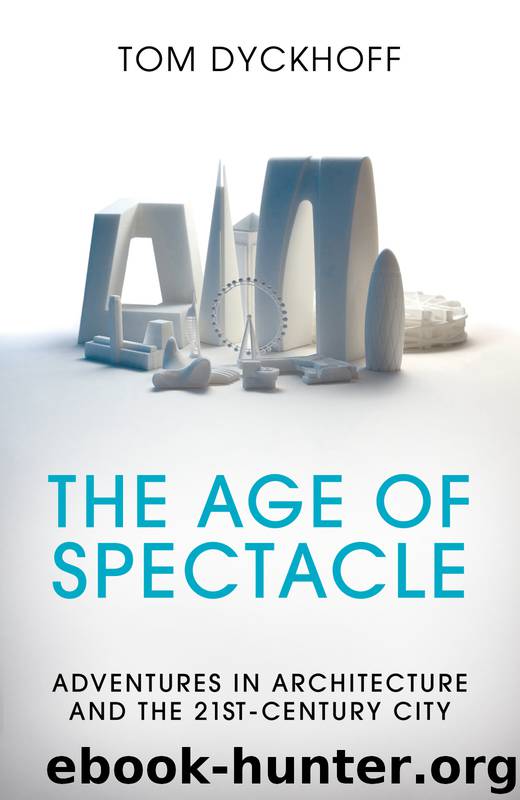The Age of Spectacle by Tom Dyckhoff

Author:Tom Dyckhoff
Language: eng
Format: epub
Publisher: Random House Books
Malls without walls
Ironically, though, in the land that invented it, the mall is metamorphosing once again. US mall building has slumped since 1990. Trashier malls are being ‘de-malled’, their arcades opened to the air and shops installed with entrances onto streets. It’s all about ‘lifestyle centres’ now, like New Jersey’s Xanadu, mixing shops, restaurants, theme parks, even schools and churches around a ‘Main Street’ – like the very thing malls were meant to replace: downtown. They’re cheaper than conventional malls to build and maintain, and their ‘retail experience’ is judged more stimulating by America’s easily bored consumers, who now demand places like ‘mom-friendly’ malls, tailor-made for their demographic niche. Meanwhile, in the old downtown, developers buy up swathes of the conventional streetscape to create ‘malls without walls’, or group businesses together to manage the space as ‘business improvement districts’. And there’s always China. In 2004, Beijing’s five-storey Golden Resources Mall, all 6 million square feet of it, knocked Canada’s West Edmonton Mall off the top spot as the world’s largest. It, in turn, has been knocked off the top spot several times since. Each of China’s myriad cities tries to out-bling its neighbour. In 2006, for instance, half a million people witnessed the opening of Guangzhou’s Grandview Mall, containing the world’s tallest indoor fountain.
Wherever the mall, the result is much the same: ‘Downtowns have become veritable “entertainment machines” … catering to urban dwellers and suburbanites seeking something new and different.’4 To fight off the siren call of the internet, the experiential thrill of these brandscapes has to be ever more unforgettable. Each has to outdo the last on Instagram.
We owe such malls-without-walls to one man: Jon Jerde. James Rouse might have popularised the ‘festival marketplace’ mall as the saviour of downtown in the 1970s, but, soon after, Jerde brought in the showbiz. He learned his trade well. In 1984, after an apprenticeship, like Rouse, designing suburban malls, Jerde was commissioned with graphic designer Deborah Sussman to design the look of the Los Angeles Olympics. The only catch? An unOlympian budget: $10 million. How do you dress up an entire city for the world’s TVs with a few bucks? There was no money for conventional Olympic building. Instead, Jerde turned to Hollywood, designing with Sussman stage sets for the camera crews that looked fabulous in living rooms, but, in the actual, real LA streets were so insubstantial they could be packed away when the circus left town. The Los Angeles Olympics became famous for two rare feats in the Games: leaving few traces and turning a profit.
It was a lesson Jerde never forgot: pump up the melodrama and the bottom line. Jerde’s company today makes some grand claims: a billion people shop every year in one of their malls; their developments can raise property prices. ‘We put people’, Jerde once said, ‘in a popular and collective environment in which they can be most truly and happily alive.’5 But what was that environment? Like Jane Jacobs, Jerde adored the theatre of the street.
Download
This site does not store any files on its server. We only index and link to content provided by other sites. Please contact the content providers to delete copyright contents if any and email us, we'll remove relevant links or contents immediately.
Kathy Andrews Collection by Kathy Andrews(11331)
The remains of the day by Kazuo Ishiguro(8403)
Paper Towns by Green John(4805)
Spare by Prince Harry The Duke of Sussex(4792)
Industrial Automation from Scratch: A hands-on guide to using sensors, actuators, PLCs, HMIs, and SCADA to automate industrial processes by Olushola Akande(4621)
The Body: A Guide for Occupants by Bill Bryson(4590)
Be in a Treehouse by Pete Nelson(3651)
Machine Learning at Scale with H2O by Gregory Keys | David Whiting(3646)
Harry Potter and the Goblet Of Fire by J.K. Rowling(3612)
Never by Ken Follett(3536)
Goodbye Paradise(3455)
The Remains of the Day by Kazuo Ishiguro(3143)
Into Thin Air by Jon Krakauer(3132)
The Cellar by Natasha Preston(3078)
The Genius of Japanese Carpentry by Azby Brown(3041)
Fairy Tale by Stephen King(2955)
120 Days of Sodom by Marquis de Sade(2943)
Drawing Shortcuts: Developing Quick Drawing Skills Using Today's Technology by Leggitt Jim(2943)
The Man Who Died Twice by Richard Osman(2812)
